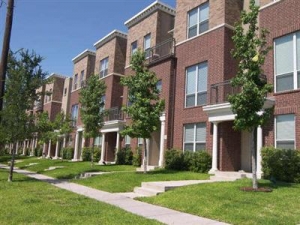High Rise, Condominiums, Lofts & Townhomes
- Can community associations, high rise, condominiums, and townhomes pursue claims for construction defects?

- Who is legally responsible for defective construction?
- What claims can I pursue?
- Are there any special procedures which must be followed prior to filing a lawsuit?
- What kind of damages can I recover?
- At any time during construction defect litigation, do members have to move out of the building?
- How do I differentiate between a construction defect and a maintenance issue?
- How much does construction defect litigation cost and how do I pay for it?
Can community associations, high rise, condominiums, and townhomes pursue claims for construction defects?
Generally, yes, if the building was constructed or rebuilt within the time period specified by law, and your claim is within other time limits. A complete answer depends on a legal analysis of the specific facts about the project and the Conditions, Covenants and Restrictions (CC & R’s) or the Declaration of Condominum Regime. (‘Governing Documents”)
Who is legally responsible for defective construction?
Depending on the facts, the developer, the general contractor, design professionals and engineers, relevant subcontractors, and material suppliers can all be liable, and usually they are insured.
What claims can I pursue?
Community associations and owners of high rise, condominiums and townhomes may pursue claims to enforce their Governing Documents and to recover damages due to defective construction in the (1) common areas, (2) “separate interests” property damaged by defects in the common areas, defects “integrally related” to common areas, and defects that the association is responsible to maintain or repair pursuant to the CC&R’s. The definitions and provisions in Governing Documents can be convoluted and confusing. We recommend that owners discuss the scope of property interests for which the association may have responsibility with a qualified legal professional with experience in community association law.
The law in most states provides that builders and developers have a basic duty to construct a building in a sound and workmanlike condition. The duty or warranty is either expressly provided in contract, by statue or implied in the law. If that duty is breached, the owner has potential claims for construction defects. The builder must follow the building plans, applicable building codes, installation requirements of the manufacturers of the products used and industry standards. Failure to meet any of these requirements is a construction defect.
California: For projects sold by the builder after January 1, 2003, community associations and owners of high rise, condominiums and townhomes can pursue claims for failure of the builder to comply with a list of “functionality standards” adopted by the California Legislature in SB 800. They may also pursue claims for breach of contract, fraud, and statutory violations.
Arizona: Claims against the builder frequently include breach of contract, breach of express warranty, and breach of implied warranty. Arizona statutes require that the owner provide notice to the builder of the defects and an opportunity to inspect, repair prior to the filing of a lawsuit. An HOA has standing to bring claims for damage to the common area individual homeowner claims on behalf of 2 or more individual owners.
New Mexico: Claims against the builder generally include breach of contract, breach of express warranty, and negligence. An HOA has standing to bring claims for damage to the common area individual homeowner claims on behalf of 2 or more individual owners.
Are there any special procedures which must be followed prior to filing a lawsuit?
Yes. Typically, the association’s Governing Documents provide for special procedures that must be followed prior to pursuing legal actions for defective construction. These procedures may include requirements of providing notice to the membership, a vote of the membership authorizing the bringing of a claim, and potentially alternative dispute resolution procedures such as mediation and arbitration. You should review requirements of your Governing Documents, and discuss them with qualified legal professionals prior to commencing any legal action.
California: In addition to the restrictions in many of the CC & R’s, in California, special procedures are required by California statute. One procedure commonly known as the “Calderon Process”, is generally required to be fulfilled prior to filing a lawsuit for defective construction. This process includes notices, exchanges of information, inspections, and mediations. Although intended to expedite claims for defective construction, the process can be manipulated by builders to add additional delay to resolving the issues if not diligently monitored by experienced professionals who understand and have experience with the process.
Another process in California that generally applies to residential properties sold for the first time after January 1, 2003, is commonly referred to as “SB 800”. This process concerns claims for failure of residential structures to comply with the “functionality standards”. Prior to an individual or association filing suit for claims of violations of “functionality standards”, the builder must first be given notice of the defects and have an opportunity to repair the conditions. The builder’s “right to repair” process is extremely technical and contains many traps for the unwary consumer in which the builder can substantially delay the process. We recommend that you retain qualified legal assistance with expertise in construction well before any attempt is made to initiate the legal process, to ensure that your dispute not only includes all appropriate claims, but also moves forward as expeditiously as possible.
Arizona: The Purchaser Dwelling Act requires giving the builder notice of the defects and an opportunity to repair prior to the filing of a dwelling action. This statute is complicated and obtaining qualified legal advice prior to putting the builder on notice of any defects is recommended. In addition, the Act also requires HOA’s to comply with the Alternative Dispute Resolution procedures contained in most CC&R’s. HOA’s are also required to have a meeting of its members before filing a dwelling action.
New Mexico: New Mexico currently does not have any special procedures such as a right to repair statute.
What kind of damages can I recover?
Usually in a construction defect action, you can recover the cost of repair, or the value of the reduction in value of the property, whichever is less, subject to certain factors that may increase your recovery. Because a community association is generally required by its Governing Documents to maintain and repair common areas, the typical measure of damages is the cost to repair. Other potentially recoverable damages include the cost of investigation, relocation and storage, and other costs recoverable by contract or statute. Punitive damages may be available in cases in which fraudulent misrepresentation or fraudulent concealment is found.
At any time during construction defect litigation, do members have to move out of the building?
No. Generally inspections and testing can take place while the units are occupied.
How do I differentiate between a construction defect and a maintenance issue?
Typically, an expert consultant is retained to analyze the conditions, and a determination is made as to whether the condition is one of deficient design, improper construction, or inadequate maintenance. Often, problems people consider to be maintenance issues are created by defects in the original construction.
How much does construction defect litigation cost and how do I pay for it?
There are a variety of ways to structure the fee arrangement, from paying for professional services based on time worked and costs incurred, to a contingent fee agreement. In a contingent fee agreement, you do not pay legal fees unless and until there is a recovery. Other costs of litigation may be charged to the client, but may also be advanced by the law firm and recovered from proceeds of case resolution. Some of the investigation and analysis expenses can also be recovered at trial if, the case reaches that stage. Your Governing Documents may also provide that you can recover attorney fees in addition to the damages.
Single Family Homes
- Who is legally responsible for defective construction?

- What claims can I pursue?
- I bought my home a few years ago. Can I still pursue legal remedies now?
- I did not buy my home from the builder; can I still file a construction defect claim?
- What kind of damages can I recover?
- During the construction defect litigation, do we have to move out of our home?
- How much does construction defect litigation cost, and how do you pay for it?
In many of our cases, we represent owners of numerous single-family, detached residences in the same development. We often hear the following questions regarding construction defect litigation on behalf of owners of single-family residences:
Who is legally responsible for defective construction?
Depending on the facts, the developer, the general contractor, the design professionals and engineers, relevant subcontractors and material suppliers can all be liable – and usually they are insured.
What claims can I pursue?
California: For projects sold by a builder after January 1, 2003, a homeowner can pursue claims for failure of the builder to comply with a list of “functionality standards” adopted by the California Legislature. The homeowner may also pursue claims for breach of contract, fraud, and statutory violations. Defects due to the negligence of a design professional or engineer, subcontractor, or material supplier are also actionable.
New Mexico: Claims against the builder generally include breach of contract, breach of express warranties and negligence. Some purchase contracts in New Mexico contain a binding arbitration agreement which attempts to limit a homeowner’s ability to file a construction defect claim in a court of law by requiring the dispute be settled by an arbitrator or a panel of arbitrators. If arbitration is used to resolve the matter, the decision that is made is as binding as one made by a court of law.
Arizona: Claims against the builder frequently include breach of contract, breach of express warranty, and breach of implied warranty. Arizona statutes require that the builder be given notice of the defects and an opportunity to inspect and make repairs prior to the filing of a lawsuit.
Some purchase contracts in Arizona contain a binding arbitration agreement which attempts to limit a homeowners ability to file a construction defect claim in a court of law by requiring the dispute be settled by an arbitrator or a panel of arbitrators. If arbitration is used to resolve the matter, the decision that is made is as binding as one made by a court of law.
I bought my home a few years ago. Can I still pursue legal remedies now?
Most likely yes. There are time limits specified in the law that govern construction defect litigation. You must act within these time limits (known as Statutes of Limitations), which vary by State depending on the type and age of the structure, type of defect, and a variety of other factors.
I did not buy my home from the builder; can I still file a construction defect claim?
Even though you didn’t buy your home directly from the builder, as long as you discover and file the lawsuit within the time limits specified by law, you still have rights under various legal claims.
What kind of damages can I recover?
Generally you are entitled to the projected cost of repair or replacement, or the amount of the reduction in value of the home due to the defects, whichever is less. However, that “whichever is less” rule is subject to a frequently applicable exception called “personal use”, resulting in recovery of the full cost of repair or replacement. Other potentially recoverable damages include the cost of investigation, relocation and storage, and other costs recoverable by contract or statute. Punitive damages are also available in cases in which fraudulent misrepresentation and/or fraudulent concealment are found.
During the construction defect litigation, do we have to move out of our home?
No. Generally inspections and any testing can take place while the residence is occupied.
How much does construction defect litigation cost, and how do you pay for it?
There are a variety of ways to structure the fee arrangement, varying from hourly fees plus costs to a contingent fee agreement. In a contingent fee agreement, you do not pay any legal fees unless, and until, there is a recovery. Other costs of the litigation are typically advanced by the law firm and recovered from proceeds of the case.
Commercial / Industrial

We Understand Municipalities

Our Goal
Our goal is to work closely with State, County, City, University and School officials and decision makers to resolve construction issues. These issues may affect an existing structure or they may block the completion of a new city facility such as a garage, police station, roadway, or perhaps a city hall, with construction costs mounting daily. We know that the infusion of funds from a successful claim, or an enlightened commitment from the general contractor to resolve the defects, can bring a stalled project back online – and the sooner the better.
We also know that most public entities are limited in what they can do to pursue construction defect claims. Many governmental entities lack the money, the expertise, and the time to determine how their projects are being impacted by construction defects and what they can do about it. Call us today for an initial no obligation no cost consultation.
Houses of Worship & Not-For-Profit Institutions

Houses of worship and other NFPs typically have difficulty in dealing with contractors who are skilled in creating cost overruns. A house of worship’s Board of Overseers or the Board of Trustees for the NFP will naturally become concerned and should seek legal counsel if these issues arise. Kasdan Weber Turner has assisted various houses of worship in such circumstances. Our firm takes particular pride in assisting these organizations because of the valuable societal, moral, and cultural missions that these institutions undertake.
The management of documents is the number one challenge in construction claims and the firms approach is to designate a senior attorney to personally discover, review, and organize the majority of pertinent documents during all phases of the mediation or litigation. We do this because not all important documents are made available by the contractor. Once these documents have been properly identified and analyzed, the resulting negotiations toward settlement may accelerate to successful conclusion.
One example of this approach would be when Kasdan LippSmith Weber Turner assisted a church in completing a new church building. Our firm helped move the Church Board from a project plagued with change orders, cost overruns, substantial delays, and serious defects, to a fully completed structure. The church also received monetary compensation.

